Topics and outcomes
Expected outcomes: Understand the different types of directional valve with examples of the issues and how they are used.
Level: 2-4 Novice to improver
Topic covered: Check valve ciruits
- 2 way 2 position valves
- 3 way 2 position valves
- 4 way 3 position valves
- Importance of loads on valve selection
Check valve load holding experiment
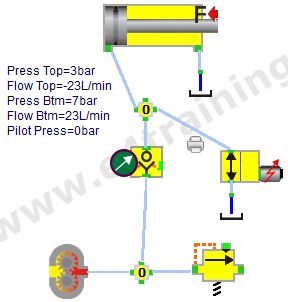
 Question: What function does a check valve perform?
Question: What function does a check valve perform?
 Experiment: Open circuit Directional/1_Check Valve Testing. Operate the solenoid valve to understand how the check valve and circuit control the cylinder. (Note! Lowering starting can take longer than real life)
Experiment: Open circuit Directional/1_Check Valve Testing. Operate the solenoid valve to understand how the check valve and circuit control the cylinder. (Note! Lowering starting can take longer than real life)
Check valve rectifier experiment
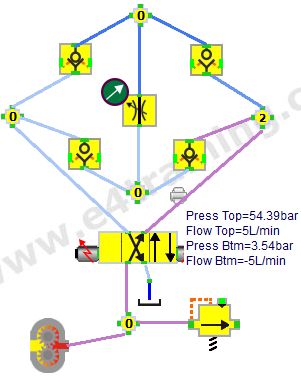
 Question: What does a check valve rectifier circuit do?
Question: What does a check valve rectifier circuit do?
 Experiment: Open circuit Directional/2_Check Valve Rectifier. Drag the test gauge onto the flow control orifice. Operate the directional valve and observe the flow rate and direction.
Experiment: Open circuit Directional/2_Check Valve Rectifier. Drag the test gauge onto the flow control orifice. Operate the directional valve and observe the flow rate and direction.
PO check valve experiment
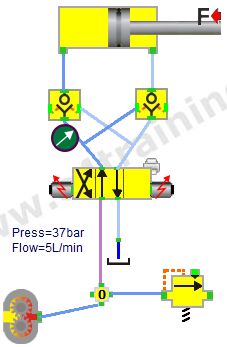
 Question: What happens when a check valve pilot is pressurised?
Question: What happens when a check valve pilot is pressurised?
 Experiment: Open circuit Directional/3_Directional Valve with PO Checks. Move the gauge onto the pipelines under the left check valve. Operate the valve and observe how the line pilot pressure while lifting. Repeat for the right-hand check valve.
Experiment: Open circuit Directional/3_Directional Valve with PO Checks. Move the gauge onto the pipelines under the left check valve. Operate the valve and observe how the line pilot pressure while lifting. Repeat for the right-hand check valve.
2 way 2 position valve experiment
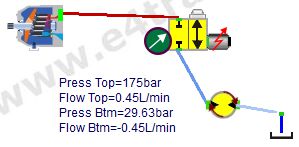
 Question: How does the motor rotate backward?
Question: How does the motor rotate backward?
 Experiment: Open Directional/4_2way 2posn Valve. Click on the solenoid to operate the valve.
Experiment: Open Directional/4_2way 2posn Valve. Click on the solenoid to operate the valve.
 Question: Is the flow zero when a 2 way 2 position valve is shut?
Question: Is the flow zero when a 2 way 2 position valve is shut?
 Experiment: Move the test gauge over the 2 way valve. Observe the pressure difference and flow across the valve. Click on the valve to change the valve's internal clearance and recheck leakage.
Experiment: Move the test gauge over the 2 way valve. Observe the pressure difference and flow across the valve. Click on the valve to change the valve's internal clearance and recheck leakage.
3 way 2 position valve experiment
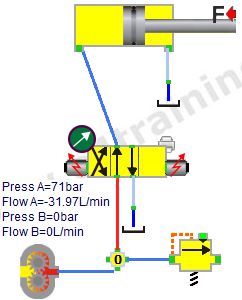
 Question: How does the cylinder retract?
Question: How does the cylinder retract?
 Experiment: Open Directional/5_3way 2posn Valve. Click on the cylinder rod to see and edit the loads. A negative force will try to extend the cylinder.
Experiment: Open Directional/5_3way 2posn Valve. Click on the cylinder rod to see and edit the loads. A negative force will try to extend the cylinder.
 Question: Are all 3 way 2 position valves identical?
Question: Are all 3 way 2 position valves identical?
 Experiment: Although this valve looks simple, some require a low-pressure return line connection, and all make different line connections as the valve crosses between the center condition. Although not in this simulation as the response is not dynamic enough to notice.
Experiment: Although this valve looks simple, some require a low-pressure return line connection, and all make different line connections as the valve crosses between the center condition. Although not in this simulation as the response is not dynamic enough to notice.
4 way 3 position valve experiments
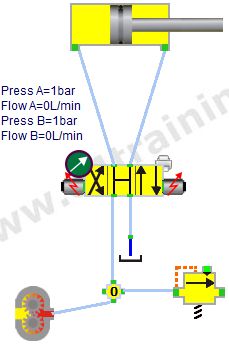
< Question: How important are actuator loads in valve selection?
Question: How important are actuator loads in valve selection?
 Experiment: Open Directional/6_4way 3posn Valve. Click on the cylinder rod to see the loads on the actuator. Cylinder friction is set to 1000N e.g. 3-4 bar seal friction.
Experiment: Open Directional/6_4way 3posn Valve. Click on the cylinder rod to see the loads on the actuator. Cylinder friction is set to 1000N e.g. 3-4 bar seal friction.
 Question: Why is seal friction useful?
Question: Why is seal friction useful?
 Experiment: Reduce the seal friction to 10N and observe what happens. Move the test gauge to see where the pressure comes from and consider why the cylinder moves.
Experiment: Reduce the seal friction to 10N and observe what happens. Move the test gauge to see where the pressure comes from and consider why the cylinder moves.
 Question: Do loads consist of a mass or force?
Question: Do loads consist of a mass or force?
 Experiment: Loads can be a mass * gravity, for set cylinder angle or a +/- force. This simulation does not calculate acceleration forces or reflected mass but you will need a proportional valve if operating at the highest speeds.
Experiment: Loads can be a mass * gravity, for set cylinder angle or a +/- force. This simulation does not calculate acceleration forces or reflected mass but you will need a proportional valve if operating at the highest speeds.
 Question: Will directional valves support all loads?
Question: Will directional valves support all loads?
 Experiment: Observe what happens when you increase the mass to 2000kg, then change the angle to 90.
Experiment: Observe what happens when you increase the mass to 2000kg, then change the angle to 90.
 Question: What pressure does the load generate?
Question: What pressure does the load generate?
 Experiment: Move the test gauge over the directional valve. Raise and lower the cylinder and read the A and B line pressures.
Experiment: Move the test gauge over the directional valve. Raise and lower the cylinder and read the A and B line pressures.
 Question: How do forces differ from mass loads?
Question: How do forces differ from mass loads?
 Experiment: Change the force to both positive and negative values. Compare load pressure with calculated mass equivalent.
Experiment: Change the force to both positive and negative values. Compare load pressure with calculated mass equivalent.
 Question: Which center condition is best?
Question: Which center condition is best?
 Experiment: Click the directional valve and change the center condition using the drop-down menu. Explore how each type performs with different loads.
Experiment: Click the directional valve and change the center condition using the drop-down menu. Explore how each type performs with different loads.
Diagnose issues with directional circuits
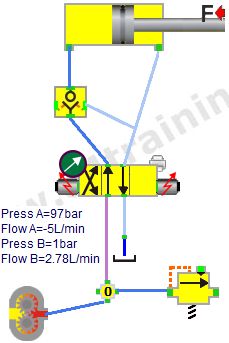
 Question: Diagnose the cylinder lower instability?
Question: Diagnose the cylinder lower instability?
 Experiment: Open Directional/Diagnose 1 PO Check. Raise and lower the cylinder. Change different parameters until you remove the judder and understand what causes it.
Experiment: Open Directional/Diagnose 1 PO Check. Raise and lower the cylinder. Change different parameters until you remove the judder and understand what causes it.
 Question: Diagnose the pressure oscillations?
Question: Diagnose the pressure oscillations?
 Experiment: Open Directional/Diagnose 2 Cyl PO Check. Why is the pressure oscillating in the center position. Change different parameters until you remove the issue and understand what causes it.
Experiment: Open Directional/Diagnose 2 Cyl PO Check. Why is the pressure oscillating in the center position. Change different parameters until you remove the issue and understand what causes it.
Directional valve and motor experiment
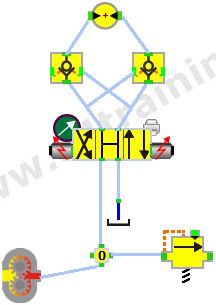
 Question: Experiment with a directional control valve and motor circuit?
Question: Experiment with a directional control valve and motor circuit?
 Experiment: Open Directional/Test 1 Direct POCheck Motor. Experiment with different loads, flows, pressure and valve configurations.
Experiment: Open Directional/Test 1 Direct POCheck Motor. Experiment with different loads, flows, pressure and valve configurations.
Directional FCV and POCheck experiment
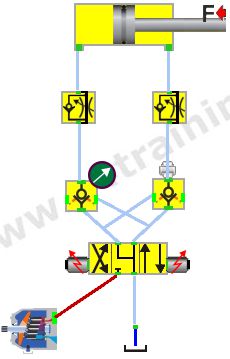
 Question: Experiment with a Directional FCV POcheck and cylinder circuit?
Question: Experiment with a Directional FCV POcheck and cylinder circuit?
 Experiment: Open Directional/Test 2 Direct FCV POCheck Cyl. Experiment with different loads, flows, pressure and valve configurations.
Experiment: Open Directional/Test 2 Direct FCV POCheck Cyl. Experiment with different loads, flows, pressure and valve configurations.
 Question: Build and test your own circuits?
Question: Build and test your own circuits?
 Experiment: Click the spanner icon to build and test your own circuit. Enter the loads and sizes from equipment nearby and compare performance results.
Experiment: Click the spanner icon to build and test your own circuit. Enter the loads and sizes from equipment nearby and compare performance results.